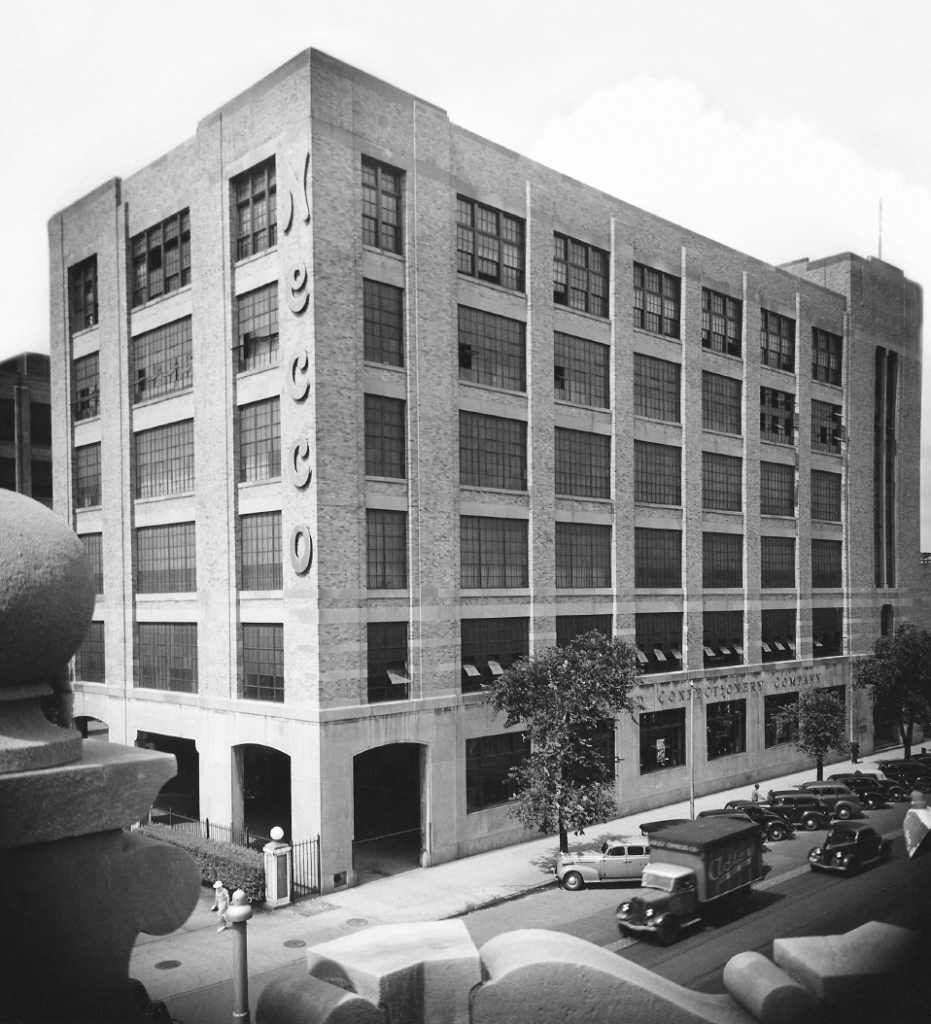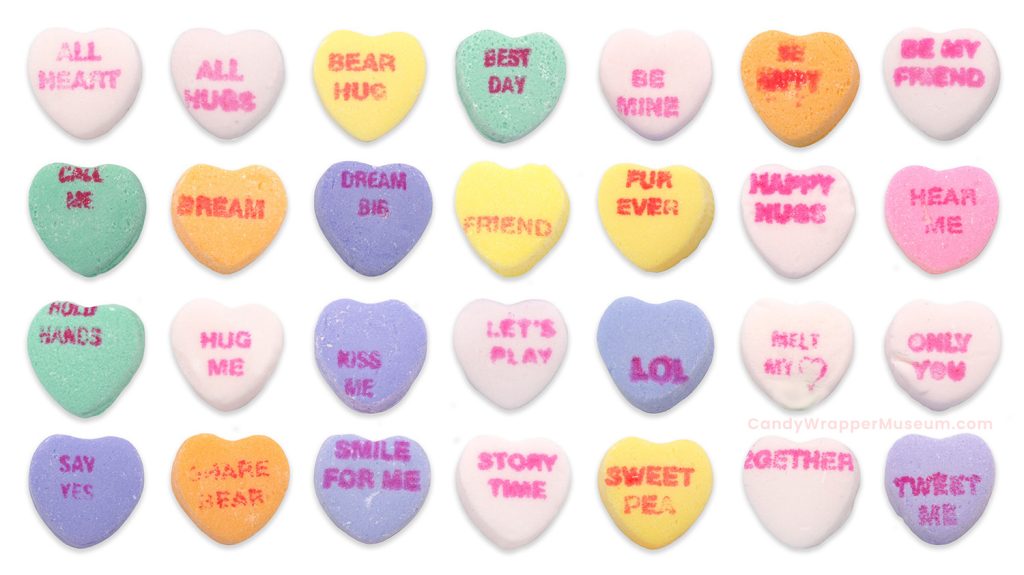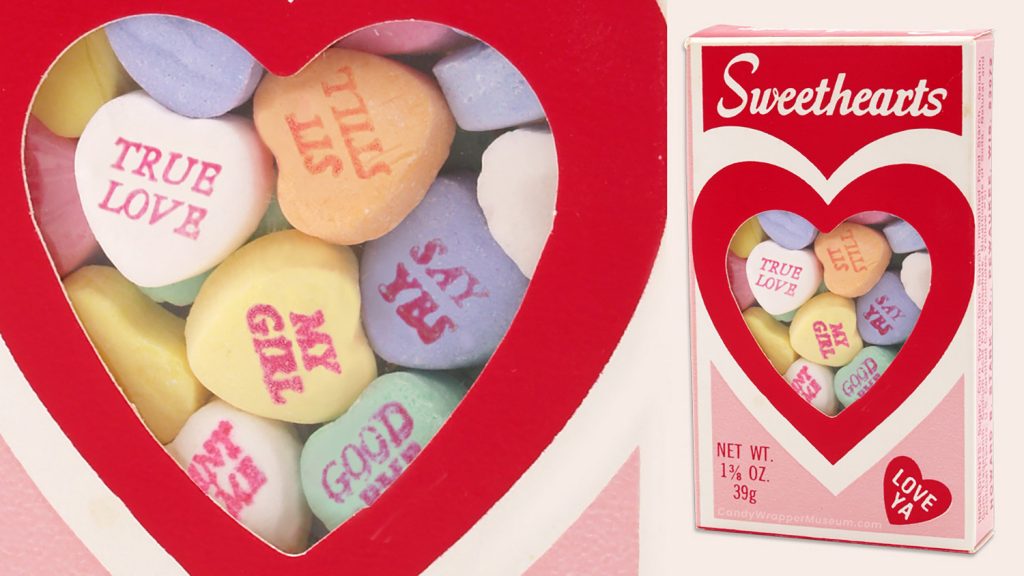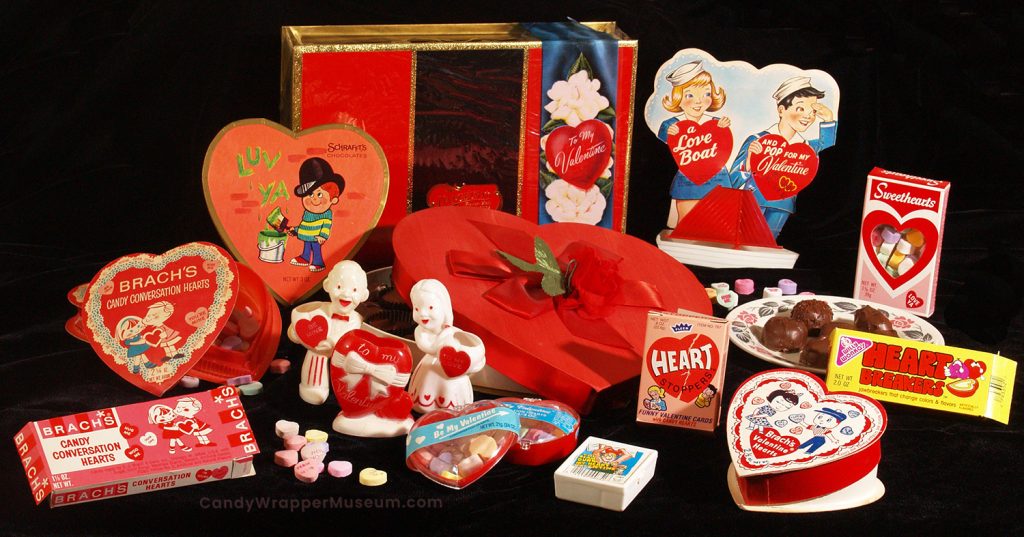
Read the full interview with Darlene Lacey below.
Darlene Lacey started The Candy Wrapper Museum in 1975, when she was just a teenager. She says, “I had the idea to collect candy wrappers, but I wanted to do it with a purpose. I always loved roadside attractions and the way that ordinary things could become extraordinary things that people wanted to see.” Her first object in the collection was a box of Stark’s Nice Mice. Decades later, she met her husband Joe because of that first object in her collection. Lacey tells me, “It was a favorite candy of his, too, when he was young. When he saw it on my website, he wrote to me, and the rest is history.”
Lacey lives in California but has become entangled with the history of the former New England Confectionery Company (or Necco for short) through a similar type of internet fate. Necco operated in Cambridge, MA, and then in Revere until it closed its doors in 2018 after 171 sweet years. Lacey wrote a book about Necco (well, two books), after receiving an email in 2019 from Jeff Green, Necco’s former vice president of research and development. She recounts that he had seen her Candy Wrapper Museum online and “he wanted to know if I would like to take in an old scrapbook that he had saved from a sooty dumpster when Necco moved from its historic Cambridge facility to Revere.”
When Lacey received the salvaged scrapbook, she found it contained myriad wrappers and Necco ephemera dating as far back as the 1890s. According to Lacey, “Many pages had been annotated with details about each item by an unknown office worker back in the middle of the twentieth century. I like to picture a very dedicated and efficient secretary.”



Necco is probably best known for its candy wafers. Brothers in candy making Daniel and Oliver Chase founded what would go on to become Necco in the 1800s, selling candy wafers that were marketed as lozenges to apothecaries.
Later, in 1866, Oliver invented a machine to mechanize the process of cutting the wafer discs, an early step in industrializing how candy was produced. The inventive brothers began experimenting with printing words on the candies. The printed candies were called “conversation candies” and came in various shapes like on the original disc-shaped wafers, as well as shell-shaped candies called “cockles.” The early shapes allowed for more text, with temperance movements using the candies as a means for spreading their message – examples of temperance-era messages include “Drink is the ruin of man” and “Honour your parents.”
Lacey tells me that she has quite a lot of conversation hearts-related items in her collection of about 50,000 wrappers and candy ephemera. While conversation hearts themselves are thought to be an indestructible candy (she writes to me: “Sugar never goes bad!”), the packaging of these candies and the other objects in her collection are not quite so enduring. It takes great care and intention to preserve the mundane objects we take for granted in our everyday lives. The archival work of that unnamed secretary working at Necco in the 1800s, along with the efforts of Jeff Green and Darlene Lacey to find a home for these collections, is invaluable in preserving the memory of these items.

When asked what she thinks is the importance of archiving objects from the past that others might see as trash, Lacey responds: “Everyday things that easily break and are meant to be thrown away become the rarest artifacts of the past. We think these things will always be here, but this is not the case. The world is constantly changing.”
So this Valentine’s Day, you might indulge in expressing the matters of the heart through a pastel pink or mint green candy heart that reads “Snug as a bug” or “Forever.” Or you might write something down, as plainly as you can. You might record something from the now – just in case some future generation might want to reach back through time to hold your hand, to read about life in 2024. Or you might read the diary of someone who lived through temperance (did they “dishonour” their parents, just a little bit?) Our curiosity about each other throughout time is a type of love in itself, and collecting and sharing the everyday details and ephemera of life is an expression of that love.
Read the full interview with Darlene Lacey below. more, follow @candywrappermuseum on Instagram or visit candywrappermuseum.com.
INTERVIEW TRANSCRIPT
Dana Schneider (Motif): When did you decide to collect candy wrappers?
DL: I started the Candy Wrapper Museum in 1975 when I was a teenager. I had the idea to collect candy wrappers, but I wanted to do it with a purpose. I always loved roadside attractions and the way that ordinary things could become extraordinary things that people wanted to see. So, I got the idea that I could someday make this my own roadside attraction. In 2002, I came up with a better idea. I set up the museum on the “Information Superhighway,” the World Wide Web.
DS: I read on Smithsonian Magazine’s website that you taught yourself HTML and built your website yourself. It looks great! How has the Candy Wrapper Museum evolved over the years? What is your dream for its future?
DL: Thank you! Since people don’t visit websites as much these days, I share wrappers, news, and stories mostly on social media—Facebook, Instagram, and YouTube. You can still visit the museum, too, at candywrappermuseum.com, and I have a blog at candywrappermuseum.net.
The museum itself continues to grow. I have about 50,000 wrappers and other ephemera, all collected around the museum’s mission: “a place where wrappers are to be enjoyed as art, nostalgia, and humor.” It’s hard to believe, but the museum will be fifty years old in 2025!
As for the future, my dream is that the collection will live on in a library, museum, or historic preservation organization after I’m gone, and that my nightmare (eek!) that someone will throw it away will never happen.
DS: I am researching the history of the New England Confectionery Company, which you have written about at length in Necco: An Epic Candy Tale. How did you become involved in researching Necco’s history?
DL: One day in 2019, a stranger sent me an email through the Candy Wrapper Museum. It was Jeff Green, Necco’s former Vice President of Research and Development. He wanted to know if I would like to take in an old scrapbook that he had saved from a sooty dumpster when Necco moved from its historic Cambridge facility to Revere. Of course, I said yes! This huge scrapbook turned out to be literally a time capsule. It contained all kinds of wrappers and ephemera spanning decades back to the 1890s. Many pages had been annotated with details about each item by an unknown office worker back in the middle of the twentieth century. I like to picture a very dedicated and efficient secretary.
As my husband Joe and I turned the pages, finding page after page of what were probably the sole surviving pieces of Necco’s history, we knew we couldn’t just put this away in a closet. We would scan it, photograph it, transcribe it, and exhaustively research Necco’s history to put it into a historical context. Our aim was to tell the ultimate, fact-checked, no stone left unturned history of Necco’s amazing 171-year run. It took us three years to do this, and it resulted not one, but two books to share it all. Necco: An Epic Candy Tale focuses on Necco’s extensive history. Necco: The Archive Collection is the recreation of the scrapbook and more.
This labor of love was well worth the effort, and we have received awards from the Cambridge Historical Commission and Historic New England for what we have accomplished.
DS: Were you surprised when the Necco factory in Revere closed in 2018?
DL: Like many Necco candy fans, I was not only surprised, but shocked and saddened by the news. It was quite the drama. First, the news reported that Necco was finished, then the news came that it would be saved at auction, then the auction winner defaulted, another auction was held, there was hope again, and finally, all hope was gone. Necco closed, once and for all. After 171 years. The longest run in US candy history. Fortunately, many of the Necco brands live on at other companies. Jeff Green helped set up the transfer of knowledge many times. Anyone who loves Necco candy is indebted to this man.
DS: The article is also situated within our February B issue, which is based on the theme of love. Is there any candy hearts ephemera in the Candy Wrapper Museum? What do you know about the history of conversation hearts and Necco?
DL: I love conversation hearts and have plenty of ephemera in the museum. I have boxes, bags, and even the candies themselves! Some date back to earlier than when I was born. Fun fact: sugar candies like Necco Wafers and conversation hearts are thought of as “indestructible candy.” In the right conditions, you can keep it forever. Sugar never goes bad!
Conversation hearts were invented by a Boston man named Daniel Chase in 1866. He was part of a very inventive family. His brother Oliver invented the first candy making machine in 1847 and started a company with his brothers named Chase & Co. This machine made candy lozenges, which led later to the Necco Wafer. The lozenges were a huge hit. Daniel thought they could take this a step further by printing on the candy. The Chase brothers worked together to create a way to manufacture them. They had another hit! These “conversation candies” were sold all year ’round and came in all kinds of shapes and sizes—not just hearts—and featured sayings like: “Shall We Elope?”, “Come To My Arms,” “Ask My Mother,” “Fair But Fickle,” and “One Before I Go.”
In 1901 Chase & Co. came together with two other successful Boston confectionery companies named Wright & Moody and Fobes, Hayward and Co. to form Necco (The New England Confectionery Co.). The three companies brought all their popular recipes with them, and Necco became a leader in the candy industry. So, you can thank Necco for those candy hearts!
DS: What do you think is the importance of archiving objects from the past that others might see as trash?
DL: Everyday things that easily break and are meant to be thrown away become the rarest artifacts of the past. We think these things will always be here, but this is not the case. The world is constantly changing. Also, when you collect everyday things, interesting patterns and stories emerge. The Candy Wrapper Museum was featured in a library exhibition of collections that told stories through envelope linings, matchbooks, doll hats, and even scents!
DS: What is one of your personal favorite objects in your collection?
DL: My box of Stark’s Nice Mice. It was the first item that I collected for the museum, and I met my husband, Joe, because of it! It was a favorite candy of his, too, when he was young. When he saw it on my website, he wrote to me, and the rest is history.
DS: What is the oldest object in your collection?
DL: A box that once contained Chase & Co.’s Peerless Wafers. It dates back to the 1890s!
DS: What advice would you give someone else interested in collecting and preserving history?
Do it! Collect and preserve what matters to you. Don’t concern yourself over what your collections’ monetary value may become. You will get greater personal satisfaction over the years, and your collection may not only increase in monetary value over time, but it may also become an important contribution to history, and that is the greatest reward you will receive through collecting.
